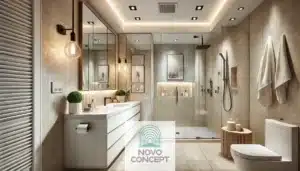Embarking on a bathroom remodeling project can be both exciting and daunting. One of the first questions homeowners often ask is: How long will it take to complete my bathroom renovation? Understanding the timeline is crucial for effective planning, budgeting, and managing expectations. The duration of a bathroom remodel depends on various factors, including the size of the bathroom, the scope of work, and the availability of materials and skilled labor.
In this guide, we’ll break down the elements that influence remodeling timelines, offer insights into realistic expectations, and explain how to streamline the process. By the end, you’ll have a clearer picture of how to bring your dream bathroom to life without unnecessary delays.
Average Timeframe for Bathroom Renovations
A typical bathroom remodel can take anywhere from two weeks to three months. This wide range is influenced by factors such as the size of the project and unforeseen challenges. Let’s explore these timeframes based on the project scale:
- Cosmetic Updates (1-2 Weeks):
If you’re focusing on minor changes, such as repainting walls, replacing fixtures, or updating accessories, your project may only take a week or two. These updates are relatively quick because they don’t require structural work or major installations. - Partial Bathroom Remodel (3-6 Weeks):
This includes upgrades like installing new tiles, updating the vanity, or replacing outdated plumbing. These projects require a bit more time due to demolition, material installation, and potential adjustments. - Full Bathroom Remodel (6-12 Weeks):
A complete overhaul involving structural changes, plumbing reconfigurations, or custom cabinetry can take several months. Coordination between multiple contractors and inspections often adds time to the project. - Luxury or Custom Remodels (3+ Months):
High-end or custom designs, especially those involving rare materials or unique layouts, may extend the timeline further. These projects demand meticulous planning, specialized craftsmanship, and custom orders.
Key Factors That Impact the Timeline
The timeline of a bathroom remodel is influenced by a combination of technical, logistical, and human elements. Below are the most significant factors to consider:
1. Scope of the Project
The extent of work is the most defining factor. Small projects with simple updates require far less time than extensive renovations that involve demolishing walls, relocating plumbing, or expanding the bathroom footprint.
2. Material Selection and Availability
Choosing materials plays a pivotal role in the timeline. Custom or imported tiles, fixtures, or countertops can take weeks—or even months—to arrive. Planning ahead and selecting readily available options can help mitigate delays.
3. Permitting and Approvals
Permits are often required for projects involving electrical work, plumbing, or structural changes. The time needed to secure permits depends on local regulations. Some municipalities process permits in days, while others may take weeks.
4. Contractor Scheduling
Reputable contractors are often booked months in advance. Starting the planning process early and securing your preferred contractor is essential to avoiding delays.
5. Unforeseen Challenges
Renovations can reveal hidden issues such as mold, outdated wiring, or structural damage. Addressing these problems adds time to the project but is crucial for long-term safety and functionality.
6. Bathroom Size
Smaller bathrooms naturally take less time to renovate, while larger master bathrooms or dual-sink setups require more work and coordination.
7. Weather Conditions
While interior projects are less weather-dependent, transporting materials or dealing with exterior elements (e.g., expanding a window) can be delayed by adverse weather conditions.
8. Homeowner Decision-Making
Delays in selecting materials or approving designs can stall progress. It’s important to stay engaged and make timely decisions to keep the project moving forward.
9. Change Orders
Changes to the original plan, such as selecting a different tile or altering the layout, can disrupt the schedule. Clear communication and upfront planning can help minimize these interruptions.
Tips for Staying on Schedule
To ensure your bathroom remodel stays on track, consider the following tips:
- Plan Ahead:
Start by defining your goals, creating a budget, and researching contractors. Early planning reduces the risk of last-minute decisions. - Choose Materials Early:
Select and order all materials before the project begins. This avoids delays caused by backorders or extended shipping times. - Hire Experienced Contractors:
Work with a reputable and experienced team. Skilled professionals are more likely to stick to the timeline and deliver quality results. - Communicate Clearly:
Maintain open communication with your contractor. Regular updates and progress checks ensure everyone is aligned. - Be Flexible with Timing:
While sticking to a schedule is ideal, being flexible allows your team to address unexpected challenges without sacrificing quality. - Prepare for Contingencies:
Allocate extra time and budget for unforeseen issues. A cushion of 10-20% is recommended for most projects.
Stages of a Bathroom Remodel
To better understand the timeline, it helps to break down a typical bathroom renovation into stages:
1. Planning and Design (1-3 Weeks)
- Consult with designers or contractors to create a layout.
- Finalize material selections and establish a budget.
- Obtain necessary permits.
2. Demolition (1-3 Days)
- Remove old fixtures, flooring, and walls as needed.
- Ensure the area is prepped for new installations.
3. Plumbing and Electrical Work (1-2 Weeks)
- Reconfigure plumbing or wiring if required.
- Install rough-ins for new fixtures, lighting, and outlets.
4. Structural Changes (1-2 Weeks)
- Expand the space or alter layouts, such as moving walls.
- Address any hidden issues like mold or outdated wiring.
5. Flooring and Walls (1-2 Weeks)
- Install new flooring, tiles, and drywall.
- Apply paint or wall treatments.
6. Fixture Installation (1 Week)
- Set up the bathtub, shower, toilet, sink, and vanity.
- Ensure everything is properly connected and functioning.
7. Final Touches (1-2 Weeks)
- Add mirrors, accessories, and decorative elements.
- Conduct inspections and address any punch-list items.
Frequently Asked Questions
Q: Can I stay in my home during a bathroom remodel?
Yes, for minor updates or single-bathroom projects, staying at home is possible. However, for major renovations, temporary relocation may be more convenient.
Q: How do I choose the right contractor?
Look for licensed, insured professionals with positive reviews and a proven track record. Request references and detailed quotes before making your decision.
Q: What are the most common causes of delays?
Delays often stem from material backorders, permitting issues, unforeseen problems like mold, or homeowner-induced changes.
Q: Is a DIY bathroom remodel faster?
While DIY projects can save money, they often take longer, especially for inexperienced renovators. Professional teams are typically more efficient.
Where to Find Trusted Bathroom Remodeling Experts
When planning a bathroom remodel, working with experienced professionals is essential. Novo Concept specializes in creating beautiful, functional bathrooms tailored to your needs. From initial design to final installation, our team ensures your project stays on schedule and meets the highest standards. We’re here to help. Contact us today to schedule a consultation and take the first step toward your dream bathroom.
Transforming Your Space: The Ultimate Guide to House Remodeling






